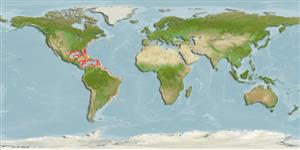Environment: milieu / climate zone / depth range / distribution range
Ecologie
marien bathydemersaal; diepte 326 - 2304 m (Ref. 37039). Deep-water
Western Central Atlantic: North Carolina, USA to Suriname, including the Gulf of Mexico and the Caribbean Sea.
Grootte / Gewicht / Leeftijd
Maturity: Lm ? range ? - ? cm
Max length : 109 cm TL mannelijk / geslacht onbekend; (Ref. 37039)
Wervels: 200 - 205. Other characteristics: Color brown to gray, with vertical fins edged in black and stomach and intestine black. Lateral line to anus number 60-64.
Minimum depth from Ref. 58018.
Levenscyclus en paargedrag
Maturities | Voortplanting | Spawnings | Egg(s) | Fecundities | Larven
McEachran, J.D. and J.D. Fechhelm, 1998. Fishes of the Gulf of Mexico. Volume 1: Myxiniformes to Gasterosteiformes. University of Texas Press, Austin. 1112p. (Ref. 37039)
Status op de Rode Lijst van het IUCN (Ref. 130435)
Gevaar voor de mens
Harmless
Gebruik door de mens
Tools
Speciale rapporten
Download XML
Internetbronnen
Estimates based on models
Preferred temperature (Ref.
123201): 4.6 - 10.7, mean 6.1 °C (based on 217 cells).
Fylogenetische diversiteitsindex (Ref.
82804): PD
50 = 0.5312 [Uniqueness, from 0.5 = low to 2.0 = high].
Bayesian length-weight: a=0.00089 (0.00036 - 0.00223), b=2.98 (2.77 - 3.19), in cm total length, based on LWR estimates for this (Sub)family-body shape (Ref.
93245).
Trofisch niveau (Ref.
69278): 3.5 ±0.5 se; based on size and trophs of closest relatives
Weerstandsvermogen (Ref.
120179): laag, minimale populatieverdubbelingstijd 4,5-14 jaar (Assuming tmax>10).
Fishing Vulnerability (Ref.
59153): High to very high vulnerability (65 of 100).
